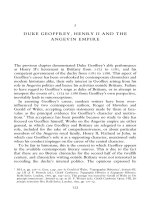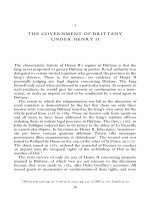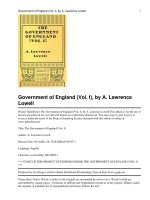The government of Brittany under Henry II
Bạn đang xem bản rút gọn của tài liệu. Xem và tải ngay bản đầy đủ của tài liệu tại đây (86.68 KB, 17 trang )
3
THE GOVERNMENT OF BRITTANY
UNDER HENRY II
The characteristic feature of Henry II's regime in Brittany is that the
king never purported to govern Brittany in person. Royal authority was
delegated to certain trusted ministers who governed the province in the
king's absence. There is, for instance, no evidence of Henry II
personally judging any legal dispute concerning Brittany. The king
himself only acted when petitioned in a particular matter. In response to
such petitions, he would give his consent or con®rmation to a trans-
action, or order an inquest or trial to be conducted by a royal agent in
Brittany.
The extent to which the administration was left to the discretion of
royal ministers is demonstrated by the fact that there are only three
known writs concerning Brittany issued in the king's own name for the
whole period from 1158 to 1189. These are known only from mentions
and all seem to have been addressed to the king's resident of®cers
ordering them to initiate legal processes in Brittany. The ®rst, c.1167, to
John de Subligny ordered him to do justice to the abbey of La Vieuville
in a particular dispute. In his return to Henry II, John states, `mandaver-
atis per breve vestram quatinus abbatiam Veteris villa omnesque
possessiones illius manuteneram et defenderam'. The second writ was
issued to Rolland de Dinan in the case of the relics of St Petroc in 1177.
The third, issued in 1181, ordered the seneschal of Rennes to conduct
an inquest into the temporal rights of the archbishop of Dol in the
marshes of Dol.
1
The texts survive of only six acts of Henry II concerning property
situated in Brittany, of which two are not relevant to this discussion
because they were made in 1182, after Duke Geoffrey's accession. All
record grants to monasteries or con®rmations of their rights, and were
1
BN ms latin 5476, pp. 97±8 and ms fr. 22325, pp. 522±3; DRF, p. 181; Enque
Ã
te, p. 77.
76
discussed in the previous chapter in the context of Henry II and the
Breton church.
2
The total record of Henry II's acts in relation to the royal
administration of Brittany between 1158 and 1181 thus consists of four
grants or con®rmations to monasteries (at least two of which were
made outside Brittany), and three writs.
3
Evidently, Henry II did not
govern Brittany in person, or even have any regular involvement in its
government.
Neither was royal government of Brittany comprehensive. Royal
authority was exercised in the counties of Nantes (from 1158), Rennes
and Cornouaille (from 1166) and the Broe
È
rec (from as late as 1175).
Le
Â
on was subjected to Angevin rule only in 1179, so discussion of this
region is postponed to a later chapter on the reign of Duke Geoffrey.
There is no evidence that royal authority was exercised at all in
Tre
Â
guier and Lamballe, where there were no ducal domains. Henry II
left the internal government of these two major baronies to their
trustworthy lords: the loyal comes Henry and, in Lamballe, the descen-
dants of Geoffrey Boterel II.
In each of the counties of Nantes, Rennes and Cornouaille, a separate
royal administration was established. The chief royal of®cer in each
county, the seneschal, was answerable directly to the king. The situation
in the Broe
È
rec is more obscure, due to a lack of contemporary
documents. There is no reference to a seneschal of the Broe
È
rec earlier
than the reign of Duke Geoffrey.
Discussions of Henry II's government of Brittany tend to focus on
Angevin innovation, and the innovation most commonly cited is the
creation of the of®ce of `seneschal of Brittany'. As I have argued
previously, I do not attribute the creation of this of®ce to Henry II.
Rather, it seems to me that Henry II's government of Brittany was
characterised by considerable ¯exibility of personnel and their duties.
This is epitomised by the role played in Brittany, and elsewhere, by a
succession of trusted ministers as `principal royal agent', that is, being
the king's general representative in a province, and expert on that
province, along with discharging other duties in royal service. Henry
II's principal agents for Brittany were William ®tzHamo, from c.1169 to
2
Con®rmation for Redon (Cart. Redon, p. 744, note 2; Actes d'Henri II, no. cclix); con®rmation
for Rille
Â
(Calendar of Patent Rolls, Henry III, 1247 ±1258, London, 1908, pp. 382±3); charter for Le
Tronchet (BN ms fr. 22319, p.238; Actes d'Henri II, no. cccxxxv); con®rmation for Locmaria
(AD Finiste
Á
re, 27H 2); determination of dispute concerning Saint-Magloire de Lehon (see above,
p. 65).
3
The charter for Redon, given at Thouars, and the con®rmation for Locmaria, given at Le Mans.
The charter for Le Tronchet has no place-date.
The government of Brittany under Henry II
77
his death in 1172, and Rolland de Dinan, from 1175 to 1181.
4
The
principal agent had an important role in Henry II's court, but arguably
more in¯uential for Breton law and society was the regional govern-
ment under the Angevins.
the county of nantes
Between 1158 and 1166, the county of Nantes was the only part of
Brittany subject to the king's immediate lordship and government.
To what extent the administration of the county of Nantes was
altered during the successive reigns of Counts Hoe
È
l (1148±56) and
Geoffrey (1156±58) is unknown. Possibly some change of personnel
had occurred, since the prepositus of Nantes under Count Hoe
È
l was not
a member of the family of hereditary prepositi.
5
Alfred de Sion was a
minor baron, whose estates were situated at the extreme north of the
county of Nantes.
6
Nothing at all is known of the administration of
Nantes under Count Geoffrey.
The administration was shaped by the presence in the county of the
count/duke. After Duke Alan IV succeeded his younger brother as
count of Nantes, around 1103, he and his son Conan III seem to have
made Nantes their principal residence.
7
The mid-twelfth-century
counts, Hoe
È
l and Geoffrey, had no territorial possessions outside the
county. The administration was thus designed to function under the
personal supervision of the count/duke. This, too, had been the
situation in the counties of Anjou and Poitou until the mid-twelfth
century. When the count was obliged to reside outside the county, in
both cases, the solution was to delegate comital powers to the count's
household seneschal. In the case of Anjou, a seneschal attached to the
comital household ®rst appears between 1060 and 1085, about the same
time as in Brittany. J. Boussard charts the evolution of the `seneschal of
Anjou' from a household of®cer to `un ve
Â
ritable vice-comte'. Boussard
ascribes the transformation to the reign of Henry II, speci®cally around
1165±80. It was in this period that a count of Anjou, Geoffrey
4
J. Everard, `The Justiciarship in Brittany and Ireland under Henry II', Anglo-Norman Studies,20
(1998), 87±105.
5
N.-Y. Tonnerre, Naissance de la Bretagne: Ge
Â
ographie historique et structures sociales de la Bretagne
me
Â
ridionale (Nantais et Vannetais) de la ®n du VIIIe a
Á
la ®n du XIIe sie
Á
cle. Angers, 1994, p. 532;
Preuves, cols. 453±4, 468±9, 472, 487 and 524. This family is last recorded in of®ce in 1133 (Cart.
Redon, no. lxxiv).
6
Preuves, col. 617. Since Alfred de Sion witnessed a charter of Conan III (Actes ine
Â
dits, no. xxxv),
it is possible the change had occurred before 1148. The family also had interests in the Nantes
area, possibly as the result of ducal grants (`Actes de Buzay', no. 49; AIV, 1F456).
7
Tonnerre, Naissance de la Bretagne, p. 533.
Brittany and the Angevins
78
Plantagenet, ®rst began to govern another province, as duke of
Normandy from 1144. In the case of Poitou, William de Mauze
Â
, father
and son, had been seneschals of the counts of Poitou since at least 1096.
Eleanor of Aquitaine ceased to reside in Poitou when her husband
became King Louis VII. In c.1138, Louis VII provided for the govern-
ment of Poitou in their absence by appointing William de Mauze
Â
`seneschal of Poitou'. William de Mauze
Â
probably died in 1148 or 1149,
and when Poitou passed from Louis VII to Henry II in 1152, a new
`seneschal of Poitou' was appointed, Eble de Maule
Â
on.
8
Thus the
`seneschal of Anjou' and the `seneschal of Poitou' became the superior
of®cer in the administration of each county.
The appearance of a `seneschal of Rennes' under Duke Conan III
represents a similar development occurring in Brittany at about the
same time. No such of®cer was required in Nantes before 1158 due to
the presence of the count. The administration of the county of Nantes
in 1158, therefore, probably closely resembled the administration of
Anjou of a generation earlier.
After Conan IV yielded the city of Nantes and `Media' at Avranches
in September 1158, the king hurried south to take possession of his new
acquisition. Robert de Torigni records, with unfortunate vagueness,
that Henry II took possession of the city of Nantes, `qua accepta et
disposita ad libitum'.
9
Whatever this means, it can be surmised that the
king made such arrangements as were necessary for the county to be
governed in his absence. It certainly involved a reform which would
have seemed obvious to the Angevin king: the creation of the of®ce of
`seneschal of Nantes', a royal delegate who would represent the king in
the county of Nantes. It has been asserted that Henry initially appointed
a baron of the county, John de Goulaine, as `gouverneur de Nantes',
but not upon any reliable authority.
10
Henry II's charter for the abbey
of Redon, probably made in October 1158, was addressed to the king's
`dapifer' and `ministris', and attested by William ®tzHamo, styled
`dapifer Nannetensis'.
11
The king's charter for Redon is the only known document in which
8
L. Halphen, Le comte
Â
d'Anjou au XIe sie
Á
cle. Paris, 1906, p. 192; J. Boussard, Le comte
Â
d'Anjou sous
Henri II Plantagene
Ã
t et ses ®ls (1151±1204), Paris, 1938, pp. 113±27; A. Richard, Les comtes de
Poitou (Paris, 1903) i, pp. 414 and 420, ii, pp. 48±9, 66, 71, 83, 87±8, 95±6, 115±6.
9
RT, i, p. 313.
10
A. Guillotin de Courson, Les grandes seigneuries de Haute-Bretagne, iii (Rennes, 1899), pp. 151±2;
R. Kerviler, Re
Â
pertoire ge
Â
ne
Â
ral de bio-bibliographie bretonne, 11 vols., viii (Rennes, 1886±1908,
reprinted Mayenne, 1985), `De Goulaine'. John de Goulaine attested a charter of Count Hoe
È
lat
Nantes in 1149, and may have supported the Angevin regime since his younger son, Matthew,
was a courtier of Geoffrey and Constance (Charters, nos. Ge7, Ge28, C4, C17, C70; Preuves,
cols. 603, 711).
11
Cart. Redon, p. 744, note 2; Actes d'Henri II, no. cclix. For William ®tzHamo, see Appendix iii.
The government of Brittany under Henry II
79
William ®tzHamo is accorded this title, and the authenticity of the
charter is questionable. Nevertheless, a contemporary forgery would
re¯ect the scribe's understanding of William ®tzHamo's actual status,
even if he was mistaken as to the of®cial title. William was indisputably
the principal royal agent in the county of Nantes.
Several undated documents record the exercise of of®cial duties by
William ®tzHamo, styled simply `senescallus'. In all cases, they record
the exercise of judicial functions. It is unlikely that William's duties
were limited to the administration of justice; rather this was the only
one of his duties whose exercise was recorded in writing. The ®rst
document, the king's charter for Redon, gives orders to the bishop and
the seneschal of Nantes that, if anyone should injure the abbey of
Redon in respect of its rights in Gue
Â
rande and the whole of `Media',
`vos ei plenariam justitiam faciatis'.
The important role of Bernard d'Escoublac as bishop of Nantes is also
indicated in the two other documents which record William exercising
his judicial functions. A notice of the abbey of Melleray records a
dispute which was settled in the presence of Bishop Bernard and
William ®tzHamo `senescallus' at the Bouffay, the ducal castle in the
city of Nantes.
12
Second, a charter of Bishop Bernard records how William ®tzHamo
`senescalcus' conducted an inquest at Nantes into the right of the abbey
of Saint-Georges de Rennes to receive a certain part of ducal tolls on
the shipment of salt and wheat on the Loire.
13
The editor of the
cartulary of Saint-Georges de Rennes dated this charter to 1169,
apparently on the basis that the abbess concerned (`A.') was Adelaide de
Vitre
Â
(1169±89), who was abbess for only a short time before the death
of Bernard, bishop of Nantes ( January 1170). However, the abbess
could have been Adelaide de Mathefelon (1153±March 1164), as argued
by R. Blanchard. I do not, however, agree with Blanchard that the
inquest, and hence this charter, date from shortly before a con®rmation
charter issued by Conan IV at Rennes on 22 September 1158, because it
is highly unlikely that William ®tzHamo was acting as seneschal of
Nantes before Conan IV yielded the city to Henry II on 29 September
1158.
14
There are two possible ranges of dates for the charter: 29
September 1158±March 1164, and late 1169±5 January 1170. I prefer
the earlier, on the grounds that the nuns were moved to petition Henry
12
BN ms fr. 22319, p. 207. For the Bouffay, see A. Che
Â
deville and N. Tonnerre, La Bretagne
fe
Â
odale XIe-XIIIe sie
Á
cle, Rennes, 1987, pp. 34, 202, and 421.
13
'Cart. St-Georges', p. 309.
14
R. Blanchard (ed.), Cartulaire des sires de Rays 1160 ±1449, i, Poitiers, 1898, p. lxvii; `Cart.
St-Georges', pp. 309±11 and EYC, iv, no. 49.
Brittany and the Angevins
80
II or William ®tzHamo soon after Conan IV's capitulation. No doubt
they felt their title was vulnerable, since the abbey of Saint-Georges was
in Rennes and the toll was paid in Nantes, and Nantes, it now appeared,
was going to be under different lordship from Rennes for the foresee-
able future.
How long William remained in the of®ce cannot be determined. His
three acts, just described, must all date from before 1170 since Bernard
d'Escoublac, bishop of Nantes, died on 5 January 1170.
15
Around 1164,
William was the royal `seneschal of Angers', which may imply he had
left Nantes, but probably he held the of®ces concurrently.
16
From
around 1170 William seems to have been Henry II's principal royal
agent for all of Brittany, until his death in November 1172.
17
There is more evidence for William's successor as `seneschal of
Nantes', Peter ®tzGuy, another of Henry II's professional ministers.
The ®rst dated record of Peter as seneschal is a charter of 1181, which
refers to Peter ®tzGuy and Robert Doisnel (de Doniol), `senescalli
domini regis Anglie tunc Nannetensis'.
18
This leaves a period of some
eight years after William ®tzHamo's death unaccounted for, but an
undated charter of Robert, bishop of Nantes, and Peter ®tzGuy, styled
`senescallus Nannetensis', could have been made at any time after
Robert's election in January 1170.
19
I have found ®ve contemporary records of Peter ®tzGuy exercising
his of®cial duties as seneschal of Nantes. They record settlements of
disputes or other transactions witnessed by Peter and certi®ed by his
seal. It is signi®cant that all ®ve derive from only two abbeys, three from
Buzay and two from Fontevraud.
20
It is reasonable to assume that, as
seneschal of Nantes, Peter made many more charters, for the bene®t of
other parties, which have not survived.
Peter was seneschal of Nantes at least until 1183. After leaving this
of®ce, he returned to the court of Henry II, attesting a charter made at
Chinon between 1187 and 1189, and continued to be active in royal
15
`Actes de Buzay', `Introduction' p. xxxxi.
16
Y. Chauvin (ed.), Cartulaires de l'abbaye Saint-Serge et Saint-Bach d'Angers, Angers, 1997, i,
pp. 313±4; BN ms fr. 22353, p. 299 (publ. RHF, xvi, pp. 97±8); P. Marchegay (ed.),
`Cartularium monasterii Beate Marie Andegavensis', in P. Marchegay (ed.), Archives d'Anjou, iii,
Angers, 1854, pp. 82±3, 316±17.
17
See Appendix 3.
18
BN ms latin 5480, p.117; Actes d'Henri II, `Introduction', p. 413. See Appendix 3.
19
`Actes de Buzay', no. A2, p. 529. Also, Peter is styled `dapifer' in an attestation to a royal charter
made 1172 x 1175 (Actes d'Henri II, no. cccclxxxi).
20
`Actes de Buzay', nos. 24 (1182), 25 (1183), and A2 (1170 x 1184), A. Oheix (1913), Essai sur les
se
Â
ne
Â
chaux de Bretagne des origines au XIVe sie
Á
cle, Paris, 1913, pp. 193 ±5; Fontevraud, BN ms latin
5480, pp.117 (1181), and 115±6 (`1193', probably an error for 1183).
The government of Brittany under Henry II
81









